![]()
![]()
![]()
Use LEFT and RIGHT arrow keys to navigate between flashcards;
Use UP and DOWN arrow keys to flip the card;
H to show hint;
A reads text to speech;
107 Cards in this Set
- Front
- Back
|
Name the three genera of lycophytes studied.
|
Isoetes, Selaginella, and Lycopodium
|
|
|
Isoetes, Selaginella, and Lycopodium all belong to the group _____.
|
Lycophytes
|
|
|
Name the three genera of monilophytes studied.
|
Psilotum, Tmesipteris, and Equisetum
|
|
|
Psilotum, Tmesipteris, and Equisetum all belong to the group _____.
|
Monilophytes
|
|
|
What are the genera studied in the family Psilotaceae?
|
Psilotum and Tmesipteris
|
|
|
The genus Tmesipteris belongs to what family?
|
Psilotaceae
|
|
|
What is homospory?
|
the production of only one type of spores
|
|
|
What is heterospory?
|
the production of two types of spores
|
|
|
____ is the production of only one type of spores.
|
Homospory
|
|
|
____ is the production of two types of spores.
|
Heterospory
|
|
|
Which is more advanced, homospory or heterospory?
|
heterospory
|
|
|
A ____ is a leaf that evolved from an enation.
|
microphyll
|
|
|
What is a microphyll?
|
a leaf that evolved from an enation
|
|
|
What is an enation?
|
a small outgrowth of a stem or other organ
|
|
|
Microphylls are ____ leaves, and they are typically ____, ____, and ____.
|
simple; small; one-veined; unlobed
|
|
|
Microphylls occur solely in the subdivision ____.
|
lycophytes
|
|
|
[All / Some] of the leaves of lycophytes are microphylls.
|
All
|
|
|
The megaphyll represents a ____.
|
branching system
|
|
|
How did megaphylls evolve?
|
A branching system became webbed, i.e. fused together laterally by the evolution of additional tissue between them.
|
|
|
What is a sterile leaf?
|
a leaf not associated with sporangia
|
|
|
____ are leaves not associated with sporangia.
|
Sterile leaves
|
|
|
What is a sporophyll?
|
leaves associated with sporangia
|
|
|
____ are leaves associated with sporangia.
|
Sporophylls
|
|
|
The two extant genera of Psilotaceae are ____ and ____.
|
Psilotum; Tmesipteris
|
|
|
Psilotum and Tmesipteris are confined (geographically) to ____.
|
the tropics and subtropics
|
|
|
What are the five features of the family Psilotaceae?
|
- herbs lacking secondary growth
- stems dichotomously branched - absence of leaves - absence of roots - homosporous |
|
|
What family of plants lacks secondary growth, has dichotomously branched stems, and is leafless, rootless, and homosporous?
|
Psilotaceae
|
|
|
Where on the plant are synangia in the genus Psilotum?
|
the distal portions of some stems
|
|
|
A ____ is a group of sporangia fused to one another.
|
synangium
|
|
|
A synangium is a group of ____ fused to one another.
|
sporangia
|
|
|
The immature sporangia and mature sporangia of Psilotum are ____ and ____, respectively.
|
green; yellow
|
|
|
Plants of the genus Psilotum have ____ synangia.
|
trisporangiate
|
|
|
What does trisporangiate mean?
|
The synangium is composed of three sporangia.
|
|
|
Where are scales located in Psilotum?
|
- paired subtending each synangium
- scattered along aerial stems |
|

a. What is this entire structure called?
b. What are the three components called? c. What are the tiny dots? d. What are the dividers between the sections called? |
a. a synangium
b. sporangia c. spores d. sporangium walls |
|
|
Are stems of Psilotum aerial or subterranean?
|
Aerial stem is a continuation of subterranean stem.
|
|
|
Aerial stems of Psilotum are ____ (color), while subterranean stems are ____.
|
green; brown
|
|
|
The subterranean stem of Psilotum bears abundant ____.
|
rhizoids
|
|
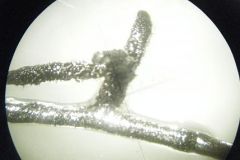
a. What genus does this stem come from?
b. Is this the subterranean or aerial portion of the stem? c. What are the numerous tiny black dots on the stem? |
a. Psilotum
b. subterranean c. rhizoids |
|
|
The gametophytes of Psilotaceae are unlike fern gametophytes because they are ____, _____, ____, and ____.
|
subterranean
axial brown branched |
|
|
The gametophytes of Psilotaceae bear ____ and ____.
|
rhizoids
gametangia |
|
|
Gametangia include ____ and ____.
|
antheridia
archegonia |
|
|
The antheridia of Psilotaceae are ____ structures.
|
spherical
|
|
|
a. What genus does the specimen belong to?
b. Does it bear leaves? c. Plant of this genus have ____ synangia. d. Where are these synangia located? |
a. Tmesipteris
b. No; leaflife appendages c. bisporangiate d. adaxial surface of short stems |
|
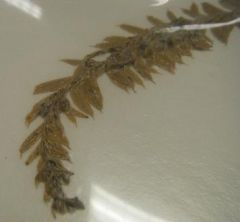
a. What genus does this specimen belong to?
b. Does it bear leaves? c. The long stem of the specimen bears ____ basally and, distally, ____, which bear ____ synangia on the ____ surface. |
a. Tmesipteris
b. No; leaflike appendages c. leaflife appendages; very short stems; bisporangiate; adaxial |
|
|
Equisetophytes date back to the ____ period.
|
Devonian
|
|
|
Name an extinct genus of Equisetophytes.
|
Calamites
|
|
|
Name the only extant genus of Equisetophytes.
|
Equisetum
|
|
|
The common name of Equisetum is ____.
|
horsetails
|
|
|
Name seven features of the genus Equisetum.
|
- herbs lacking secondary growth
- aerial and subterranean stems - simple leaves - lateral branching - whorled phyllotaxy - stems jointed below nodes - homosporous |
|
|
Both aerial and subterranean stems of Equisetum bear ____, while only subterranean stems bear ____.
|
leaves
roots |
|
|
In Equisetum, leaves of a whorl are ____ basally, forming a ____, but ____ distally as ____.
|
fused
tubular sheath distinct leaf tips |
|
|
In Equisetum, sporangia are borne on/in ____.
|
sporangiophores
|
|
|
What are sporangiophores?
|
structures bearing sporangia that are not definitely recognized as leaves or stems
|
|
|
____ are structures bearing sporangia that are not definitely recognized as leaves or stems.
|
Sporangiophores
|
|
|
In Equisetum, sporangiophores are arranged in ____ on a ____.
|
whorls; strobilus
|
|
|
What is a strobilus?
|
a cone
|
|
|
In Equisetum, strobili bear numerous ____.
|
sporangiophores.
|
|
|
What about Equisetophytes is unique among free-sporing vascular plants?
|
whorled phyllotaxy
|
|
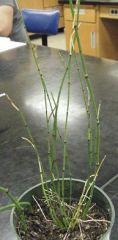
a. What species does this specimen belong to?
b. The shoots are ____. c. Joints are visible as ____. d. This species has ____ aerial stems. |
a. Equisetum hyemale
b. monomorphic c. an indentation of the stem basal to a node d. unbranched |
|
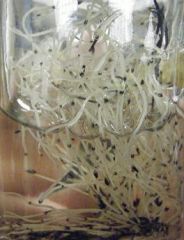
a. What is the species represented?
b. Plants of this species are ____ compared to others in its genus. c. Stems are ____ and ____. |
a. Equisetum scirpoides
b. small c. unbranched; monomorphic |
|
|
Plants of the species Equisetum arvense exhibit ____.
|
shoot dimorphism
|
|
|
Plants of the species ____ exhibit shoot dimorphism.
|
Equisetum arvense
|
|
|
What two types of shoots are present in Equisetum arvense?
|
sterile shoots
fertile shoots |
|
|
What are sterile shoots?
|
shoots lacking strobili
|
|
|
What are fertile shoots?
|
shoots with strobili
|
|

a. What is the species depicted?
b. What type of shoot is this? c. Together with the leaves at each node arise a whorl of ____, which in turn bear ____. |
a. Equisetum arvense
b. sterile c. narrow lateral branches; leaf whorls |
|

a. What species is this?
b. What type of shoot is depicted? c. The shoot bears a ____. d. Compared to the sterile shoot, it is ____, ____, and ____. |
a. Equisetum arvense
b. fertile c. terminal strobilus d. shorter, brown, and unbranched |
|
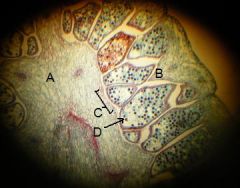
a. What genus does this belong to?
b. Name the parts A through D. |
a. Equisetum
b. - A: central stem axis of strobilus - B: sporangiophore - C: sporangium - D: spore |
|
|
Lycophytes date back to the ____ period.
|
Devonian
|
|
|
Name an extinct genus of lycophytes.
|
Lepidodendron
|
|
|
List six features of Lycophytes.
|
- herbs with little to no secondary growth
- stems, roots, and leaves present - dichotomous branching or combo of dich. and lateral - simple leaves - frequently alternate phyllotaxy - homosporous or heterosporous |
|
|
In lycophytes, sporangia are associated with ____, which may or may not be aggregated into ____.
|
sporophylls
strobili |
|
|
Species of genus/genera ____ are homosporous.
|
Lycopodium
|
|
|
Species of genus Lycopodium are [homosporous / heterosporous]
|
homosporous
|
|
|
In lycophytes, species of genus/genera ____ are heterosporous.
|
Selaginella and Isoetes
|
|
|
Species of genera Selaginella and Isoetes are [homosporous / heterosporous].
|
heterosporous
|
|
|
The common name of Lycopodium is ____.
|
club mosses
|
|
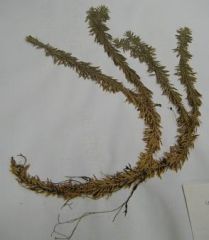
a. What species is represented?
b. The specimen has ____ roots. c. Stem branching is ____. d. Root branching is _____. |
a. Lycopodium lucidulum
b. adventitious c. dichotomous d. dichotomous |
|
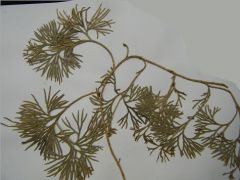
a. What species is depicted?
b. What is the yellow stemlike structure running up the middle of the photo? c. Stem branching is ____. d. Erect branching stems bear ____. |
a. Lycopodium digitatum
b. a rhizome c. dichotomous d. minute leaves |
|

a. What species is depicted?
b. On each branching system, how are strobili organized? |
a. Lycopodium digitatum
b. clustered at the ends of two long, erect, modified branches |
|
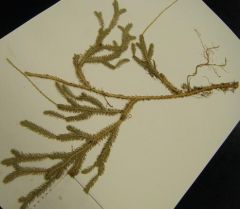
a. What species is this?
b. What is the structure oriented diagonally across the pic? c. The roots shown are ____. |
a. Lycopodium clevatum
b. rhizome c. adventitious |
|

a. What genus is this?
b. Strobili are present/absent. c. How are sporangia organized? d. What shape are sporangia? |
a. Lycopodium
b. absent c. Sporangia are borne singly, axillary to sporophylls, situated along the entire stem. d. reniform |
|
|
In many species of Lycopodium, the gametophyte is [above / below] ground.
|
below
|
|
|
Each Lycopodium gametophyte bears ____.
|
archegonia and antheridia
|
|
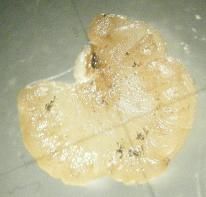
a. What is this, and what species is it from?
b. It is found [above / below] ground. |
a. gametophyte of Lycopodium obscurum
b. below |
|
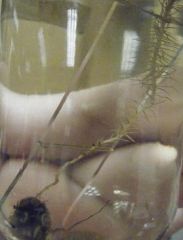
a. What is depicted in lower left?
b. What is the rest of the specimen? c. What species is this from? d. The dark structure is found [above / below] ground. |
a. gametophyte
b. sporophyte c. Lycopodium clavatum d. below |
|
|
In homosporous species, the mature gametophyte is [exosporic / endosporic].
|
exosporic
|
|
|
In heterosporous species, the mature gametophyte is [exosporic / endosporic].
|
endosporic
|
|
|
In [homosporous / heterosporous] species, the mature gametophyte is exosporic.
|
homosporous
|
|
|
In [homosporous / heterosporous] species, the mature gametophyte is endosporic.
|
heterosporous
|
|
|
What does endosporic mean?
|
Each gametophyte is enclosed by a spore wall.
|
|
|
Selaginella produces two kinds each of ____, ____, ____, and ____.
|
sporophylls
sporangia spores gametophytes |
|
|
The megagametophyte develops within a ____.
|
megaspore wall
|
|
|
The ____ develops within a megaspore wall.
|
megagametophyte
|
|
|
The megagametophyte produces ____.
|
archegonia
|
|
|
The microgametophyte produces ____.
|
sperm cells
|
|
|
Each archegonia is ____.
|
within an egg cell
|
|
|
A sperm swims to an archegonium, ____ occurs, and a zygote is formed.
|
syngamy
|
|
|
Plants of species Selaginella apoda have ____, ____, and ____.
|
adventitious roots
branched stems strobili |
|
|
In Selaginella each leaf bears a(n) ____.
|
ligule
|
|
|
In the genus ____ each leaf bears a ligule.
|
Selaginella
|
|
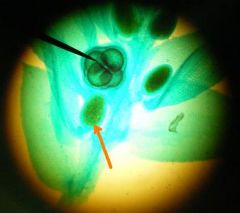
a. What species is this from?
b. What is the black pointer pointing at? c. What is the red arrow pointing at? d. What is contained within (b)? e. What is contained within (c)? |
a. Selaginella apoda
b. megasporangium c. microsporangium d. megaspores e. microspores |
|
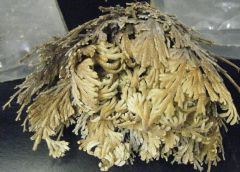
What species is depicted? Give common name also.
|
Selaginella lepidophylla
Resurrection Plant |
|
|
What is the common name of Selaginella lepidophylla?
|
Resurrection Plant
|
|
|
What is unique about Selaginella lepidophylla?
|
During periods of drought, shoots curl up and dry out to dormancy, which is then broken when moisture is available.
|
|
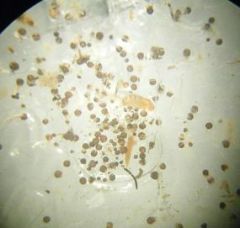
a. What is depicted?
b. In those that have split open, what is the white stuff visible? |
a. megaspores
b. the endosporic megagametophyte plant |

